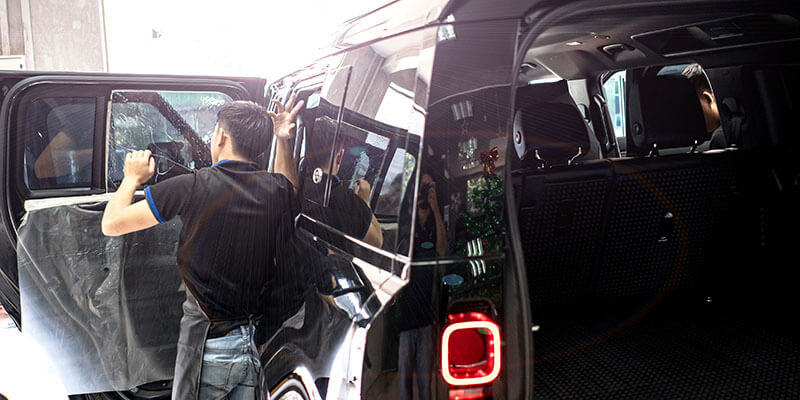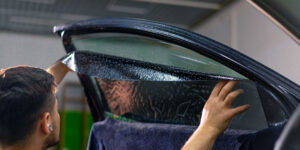When it comes to selecting the perfect window tint for your vehicle, the decision often boils down to a choice between carbon and ceramic tints—two of the most popular and high-performing options on the market. Each type offers its unique set of benefits and drawbacks, from heat reduction and UV protection to durability and cost.
But what exactly sets them apart? In this article, we’ll delve into the nitty-gritty of carbon versus ceramic window tints, comparing their composition, performance, and overall value to help you make an informed decision.
Whether you’re looking to enhance your car’s aesthetic, improve privacy, or protect your interior from sun damage, understanding the differences between these two tinting powerhouses is key.
So buckle up as we clear the haze around carbon and ceramic tints, ensuring your next automotive upgrade is nothing short of exceptional.
5 Types Of Window Tint Films
Before comparing the difference between carbon and ceramic tint, let’s take a little time to understand the window tint market by reviewing the following brief introduction to the five types
- Dyed Window Tint – The most cost-effective option. It’s a combo of dye and adhesive layers that cut down on sunlight and provide privacy inside the car. But the dye fades under solar UV exposure and becomes purple color at the end of its lifespan.
- Metalized Window Tint – Metalized tints use tiny metallic particles to block heat. This adds strength to your windows but metalized tints have a shiny appearance that might not be everyone’s cup of tea. It also will interfere with cell phone and GPS signals due to its metal properties.
- Hybrid Window Tint – the combo of dyed layer and metalized layer, which solves the shortcoming of dyed window tint: to reject more heat, you have to choose darker tints, and the problem with metalized window tint: does not render the shiny appearance that some people would not prefer. Because the metalized layer can reject heat effectively you can choose a lighter-dyed layer to have a better view through windows.
- Carbon Window Tint – Its functional layers consist of carbon particles, so it not only can reject more heat and block 99% UV but also does not have interference problems in metalized ones. Moreover, carbon window film has a matte appearance which attracts a proportion of people.
- Ceramic Window Tint – adopts ceramic particles to get better UV and heat reflection than carbon films. It can reject almost 99.9% ultraviolet (UV) radiation and up to 70% solar energy but does not sacrifice windows visibility. Most premium types for the current market.
Check out the comparison table:
| Criteria | Dyed | Metalized | Hybrid | Carbon | Ceramic |
|---|---|---|---|---|---|
| Cost | $ | $$ | $$$ | $$$ | $$$$ |
| Durability | Low | High | High | Higher | Highest |
| Heat Rejection | Moderate | High | High | Higher | Highest |
| UV Protection | Good | Better | Better | Even Better | Best |
| Glare Reduction | Yes | Yes | Yes | Yes | Yes |
| Signal Interference | No | Yes | Yes | No | No |
However, of all window tints, carbon and ceramic tint film are the most popular types in the market, now let’s review their advantages and disadvantages separately
The Pros And Cons Of Carbon Tint
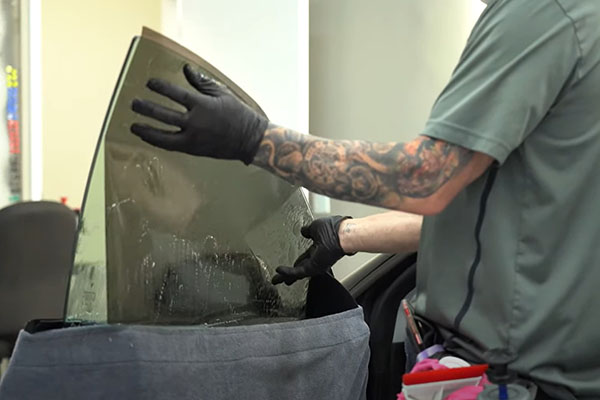
The functionality of carbon and ceramic tint film is quite different.
carbon particle layers block harmful rays mainly by absorbing them, while ceramic particle layers by reflecting them.
Bearing this point in mind, let’s review the advantages and disadvantages of the two tint films.
Pros Of Carbon Tint
- Heat Rejection – carbon tint blocks up to 70% of total solar energy to cool down the temperature in cars
- UV Rejection – carbon tint rejects up to 99% of ultraviolet rays to protect passengers and car’s interior materials from decaying
- Glare Reduction – carbon window tint looks a little darker because of its carbon particle layer, this layer not only generates a matte look but also absorbs 92% of the glare from sun lights or other lighting sources at night, so passengers in cars will not suffer from glaring lights.
- Enhanced Privacy – windows with carbon tint film do not affect the view of people inside the car, but it is hard for others to peep from outside the car.
- Matte Look – the resultant matte look by carbon layers is considered luxurious by most consumers
- Fade Resistant – unlike dyed tint film, carbon tint’s black color will not fade over time, even under UV rays.
- No Signal Interference – carbon tint does not have metal properties, so it will not interfere with your cell phone and GPS signals.
- Scratches Proof – carbon particle layer strengthens the surface hardness to some degree, so you do not worry about small scratches.
Cons Of Carbon Tint
- Limited UV Protection – ceramic tint can reflect 99.4% UV rays, whereas carbon tint only 99%. If you are looking for extreme UV protection, carbon tint might not be the ideal option.
- Matte Appearance – not everyone likes the matte appearance.
The Pros And Cons Of Ceramic Tint
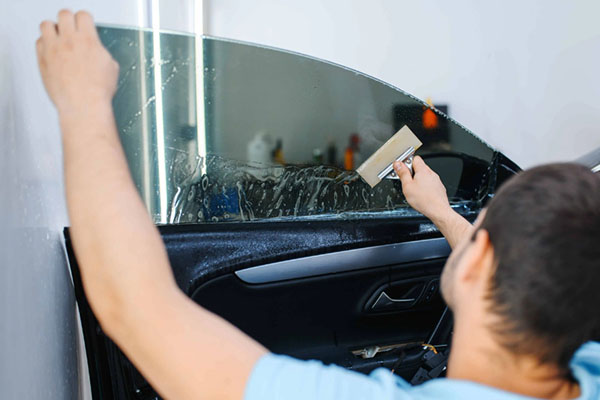
Ceramic tint might be the most premium type in the market due to the newest technology, but even the perfect thing comes with drawbacks. In other words, it can not satisfy everyone. Let’s take a look at its pros and cons.
Pros Of Ceramic Tint
- Heat Rejection – ceramic tint rejects almost 72% of solar energy, moreover, it reflects up to 96% of infrared light.
- UV Protection – unlike carbon tint, which realizes UV protection by absorbing UV rays, ceramic tint reflects the hazardous rays, which means 99.4% of UV rays do not go through the window.
- Clarity – ceramic tint has excellent properties of heat and UV rejection but does not sacrifice its visibility, however, if you choose dyed tint or carbon tint, you have to select darker ones to reach a certain level of rejection.
- Will Not Fade – the same as carbon tint, ceramic particle layer do not fade with time, so your windows will not fade and turn purple after years of sunlight.
- Nonconductive and Nonmetallic – ceramic particles in the film do not conduct electricity and also do not act as metalized tint film to block telecommunications signals.
- Unique Strength Properties – the ceramic particle layer not only enhances scratch-proof property but also adds some structural stability to the windows, so the windows could be shatter-proof to a degree.
Cons Of Ceramic Tint
- Cost – although ceramic tint outperforms other window tint in different respects, it costs you more.
- Installation Difficulty – ceramic tint’s unique strength properties give enhanced protection to windows but the strength property also adds difficulty to installation, requiring skilled workers to stick them to windows properly.
- Doesn’t Offer As Much Privacy – ceramic tint does not use heat-absorbing black pigment to block heat, so it provides a clearer view through windows, but the consequential benefit also gives others a chance to peer from outside.
What Makes Ceramic Window Tint The Best?
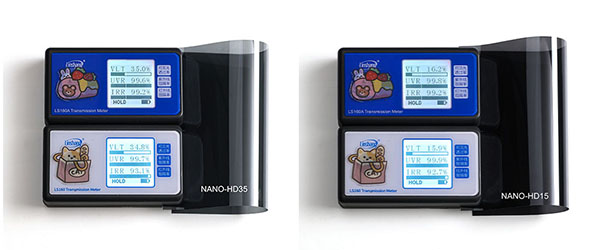
After learning the 5 common window tint films and enumerating the pros and cons of carbon and ceramic tint, we can find out that ceramic window tint is the best window tint film due to the following reasons:
- Peak Heat Reduction – utilizes nano-ceramic technology that effectively targets infrared rays to block significant heat and keep interiors cooler.
- Top-tier UV Protection – almost rejects all UV rays(99.4%), and protects your skin and your car’s interior from fading and damage.
- Non-Reflective Aesthetics – unlike metalized tint, which generates an unpleasant shiny appearance, ceramic window tint enhances your car’s overall look without the mirror-like appearance.
- Signal Clarity – ceramic tint is non-conductive, so it allows cell phone and GPS signals to pass through unhindered.
- Unmatched Durability – ceramic window tints are known for their longevity and durability. you won’t see them discolor or fade quickly, ensuring your car stays sharp for the long haul.
- Color Stability – The color of ceramic tints remains stable over time. They don’t develop that purplish hue that can happen with other tints. (e.g. dyed tint film)
- Quality and Longevity – They’re resistant to scratches and nicks compared to others. Ceramic tint maintains its integrity and function, making it a wise investment for any vehicle owner.
Carbon VS Ceramic Tint: Which One Should I Choose For My Vehicle?
Everyone has their requirements, and each tint film has different properties, so which one should be chosen depends on your needs and budget.
Ceramic window tint is the best option for most cars but is more expensive than others. Some people, who focus on functionality other than prices, think it is worth extra money to get better functions.
Carbon window tint is a good alternative for those on a tight budget, if you do not pursue extreme UV protection, carbon window tint is also a wise choice.
Frequently Asked Questions
When contemplating the best tint for your vehicle or building, it’s essential to weigh all factors related to performance and value. The following questions address common concerns to help you make a well-informed decision.
What are the key differences in heat rejection between carbon and ceramic tints?
Carbon tint films provide good heat rejection due to the carbon particles’ ability to absorb heat. Ceramic tints, on the other hand, have ceramic particles that not only absorb but also reflect heat, usually offering a higher level of heat rejection than carbon.
How effective are carbon tints at blocking UV rays compared to ceramic?
Carbon tint blocks a significant amount of UV rays but ceramic tint has the edge, as it can block up to 99% of UV radiation, which is vital for protecting your skin and the interior of your vehicle from sun damage.
Can you compare the longevity and durability of carbon tint versus ceramic?
Ceramic tint is renowned for its durability and longevity, often outlasting carbon tint. Ceramic films are less prone to fading over time due to their high-quality materials, which also contribute to a longer-lasting finish.
Are there notable differences in nighttime visibility between ceramic tint and other types?
Ceramic tint typically maintains clearer visibility at night in comparison to other tint types. Its non-metallic properties reduce glare and do not diminish clarity, making it a superior choice for nighttime driving.
What’s the typical price difference between carbon and ceramic tint installations?
Generally, ceramic tint installations are more expensive than carbon ones. The price difference reflects ceramic tints’ superior UV and heat rejection capabilities, durability, and the technology used in the ceramic particles infused in the film.
In terms of UV protection and heat rejection, is there a clear winner between nano carbon and ceramic tints?
While both nano carbon and ceramic tints offer excellent UV protection, ceramic tints usually surpass nano carbon in overall heat rejection abilities. The cutting-edge ceramic technology affords it a slight advantage in protecting against both UV rays and heat.

